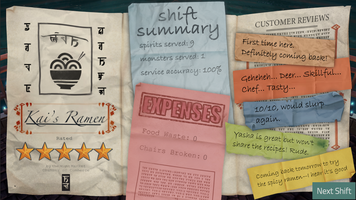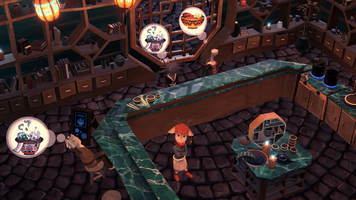Ramen Rush Reheated: Insights from three months of expanded development



Hello everyone, my name is Katya Farinsky, and I am a Director and Producer at CMDC Studios, a growing network of multi-talented game developers from the Creative Media and Digital Culture Program at Washington State University Vancouver.
Earlier this year, a record number of CMDC Studios members and first-time game developers joined our team for the PIGSquad’s June Character Creator Summer Slow Jam where we completed the game jam edition of Ramen Rush. While we were extremely proud to see the game during the final showcase stream, several members of the team felt that we had unfinished business with the final game jam build. For the past three months, a smaller group of developers from the original team have expanded and polished Ramen Rush for a brand-new Halloween release. It is incredible to see how much the game has evolved since June, and we are extremely excited to showcase our work while also sharing some of the insights we gained along the way.
Part 1: The Jam
The first edition of Ramen Rush had its fair share of challenges and successes throughout development. One of the biggest obstacles for our team was at the very beginning of the project when we started designing around the slow jam’s themes. It seemed like we had amazing ideas that either fit really well with the Character Creator theme, but not Unintended Consequences, or really strong narrative pitches that leaned into the Unintended Consequences theme and didn’t have an obvious way to incorporate the character creator aspect. Eventually, we landed on a concept that we felt was put together enough for our programmers to move forward with prototyping and our artists to start drafting concept art at the end of the first weekend.
Our team worked through several intense meetings during the first week and half of the jam as we threw everything AND the kitchen sink into a pitch doc, then proceeded to cut the majority of it, and eventually reassembled our ideas into what we thought was a manageable game scope given the amount of time left in the jam. As you may have guessed, things didn’t fully go to plan- but I won’t spoil the ending until we get there.
There are several big wins that come out of our final game jam build including 8 amazing songs in our original soundtrack, 26 illustrated icons of ramen ingredients and assembled ramen recipes, and countless 3D models of patrons, bowls of ramen, restaurant equipment, environmental pieces, and aesthetic ramen shop clutter. However, there are several features that didn’t get finished in time for the final game jam build which were disappointing to launch without.
First, several user interface components and menus weren’t as polished as we would like. We also had an uneven amount of flavor text options for the customer review screen between levels, so the game felt less alive when the same phrase repeated level after level or even multiple times on the same screen between levels. Additionally, there wasn’t a clear tutorial introducing players to the idea of making ramen. There was a significant period of confusion for players after the opening cutscene when they were dropped into the restaurant for the first time. This gap was present amongst our external and internal play testers who knew the objective of the game.
Finally, there was not a clear sign that you have transitioned to a new shift in the game jam version. Many team members thought they were playing the same level over and over during internal playtesting opportunities, even though they were playing different shifts that were intended to feel unique.
Overall, the experience was playable, but left many players disoriented because of these opportunities for polish that we couldn’t quite get to during the jam. Across the team of 43 people, our team leads spent a significant amount of time working with our artists to ensure the 2D and 3D assets we received felt cohesive and were built in a way that wouldn’t hinder game performance once everything was in-engine. We knew that carrying such a large team into the jam would come with its own unintended consequences, but we ultimately decided to not split the team because there was concern that we would end up with an unequal distribution of talent and availability given everyone’s overlapping vacation and work schedules.
Looking back at the project, it seems clearer to me that focusing so much raw, unbridled creative energy into one project over a relatively short time frame led to a project that was very hard to manage and keep on target. I learned a lot about my personal limitations as a leader because there were so many people and moving pieces during the jam. Since publishing the game jam edition of Ramen Rush, we have worked through very productive conversations about how we can better serve the amazing group people who want to work with us including splitting the work amongst several creative directors so more than one person is able to share the demands of managing multiple projects in the future. Our fall experiment using this workflow has provided very promising results and I am beyond grateful to work with a group of dedicated people who are equally willing to help each other grow and volunteer their time to mentor students that explore game development opportunities like slow jams with the PIGSquad.
Part 2: Pivoting to a Delicious Second Course
After the showcase and a post-mortem with the team, it became clear that our developers were hungry for another opportunity to develop Ramen Rush to its full potential. We took a few weeks off to rest before assembling a smaller team in late July for the Ramen Rush expansion. The first two weeks of August were spent establishing a new development schedule, setting expectations for the project, adding tasks to a Trello Board, and selecting a new launch window for the expansion near Halloween.
We knew that we needed to downshift the pace of production to accommodate everyone’s schedules since most of the team were enrolled in classes, contributing to research projects at WSU Vancouver, or working jobs across the Pacific Northwest. Our first step was to limit ourselves to one Zoom meeting on Monday nights. We were able to utilize Trello and Slack to communicate during the week, so by late August, we were able to cap meetings at 60 minutes or less because development was so focused. The second biggest decision we made was to not increase the scope of the game from our original vision in the game jam. We had clear goals with well-defined tasks that needed to be completed including improving the UI, introducing a tutorial, and polishing the progression of the game so the holistic user experience would improve significantly.
As a result, we now have a skippable tutorial, that is also repeatable, so players who want to jump straight to the gameplay and players who want extra prep-time in the kitchen are able to enjoy the game equally. We added additional transition graphics to announce the start of a new shift and worked on tweaks under the hood to make each shift feel more unique, and just the right amount of difficult to manage, as you progress through the game or replay it over time. We were also able to polish the pause menu, the review screen between levels, and add new win and lose screen artwork so transitions throughout the game feel less jarring between rounds of rushing to serve ramen.
The newest version of Ramen Rush is a realization of months of progress by developers who are passionate about making games. We cannot express how satisfying it is to see the new release and look back on all the work that’s been completed.
Part 3: “Save it for the sequel” – Wise PIGSquad Developers
Our team has learned so much by working on this game during the jam and committing to an expansion of our project afterwards. Looking back on the entire experience, I am so proud of the many hands that contributed to each release of Ramen Rush, including a significant number of developers who have never built a game before, culminating in our 6th and 7th studio releases respectively. There are still things we would love to tear apart, rebuild, and keep working on, but for now, I think we can safely say that we are saving that for the sequel.
Before signing off, I want to thank everyone supporting our development teams and the incredible games they produce. I also want to send a huge thank you to Will, Marlowe, and the entire PIGSquad Team for organizing this year’s Halloween Spooky Games Marathon and allowing us to showcase Ramen Rush.
Finally, I want to thank Dr. Dene Grigar, the CMDC Program, and the Electronic Literature Lab for their constant support over the past two years of making games at CMDC Studios. We truly could not continue to serve our network of students, alumni, and friends without your support.
I hope you found this dev log insightful. Until next time, have a safe and spooky Halloween everyone!

Leave a comment
Log in with itch.io to leave a comment.